|

WATER is life
Water—we take it for granted! We use it every
day for cooking, drinking, bathing, swimming, and fishing;
we use it for our pets, our livestock, and our backyard
birds. Although water covers almost 70% of the earth's
surface, it is not limitless. Every drop of water that
exists on the planet today was here in one form or another
the day our planet came into being!
The intake of water on a regular basis
is essential for may reasons. It's responsible for lubricating
your joints, it acts as a shock absorber in the eyes
and the spinal cord and aids in maintaining body temperature.
Water also plays an important role in respiration, digestion,
assimilation, metabolism, and waste removal. It also
keeps the pressure, acidity, and composition of all chemical
reactions in equilibrium.
Common misconception
about water:
The only time you need to drink water is when you are thirsty.
One of the greatest tragedies is the assumption that dry mouth is
the only indication of the water needs of the body. Dry mouth is
actually one of the last indicators of dehydration. By the time you
have dry mouth, many physiological functions in the body have already
began to shut down.
Vaughn
Lawrence, ND |
Water is necessary to take nutrients into the cells
and to flush wastes from the cells. Think about the amount
of water that is expelled from our bodies every day.
Copious amounts of water are required to digest food
and eliminate wastes. Water in the kidneys neutralizes
acidic wastes and sends them out in the urine. Water
is expelled during respiration and is continually being
moved through the skin to moderate temperature and flush
the tissues of the skin. Water is also required for every
metabolic process, so that nothing can happen without
water. Ultimately, when water is lacking in our cells,
organs cannot function properly and toxins are allowed
to build up.

Why should you
drink water?
 It
is an essential nutrient and makes up more than 60% of
adult body weight. It
is an essential nutrient and makes up more than 60% of
adult body weight.
 It
is needed for all body functions, such as nutrient digestion,
absorption, transport and metabolism. It
is needed for all body functions, such as nutrient digestion,
absorption, transport and metabolism.
 It
aids in body-temperature maintenance. It
aids in body-temperature maintenance.
 It
is vital to electrolyte balance. It
is vital to electrolyte balance.
 Remove
toxins & waste products from your body. Remove
toxins & waste products from your body.
 Keeps
skin healthy and glowing. Keeps
skin healthy and glowing.
 Increases
your mental and physical performance. Increases
your mental and physical performance.
 Water
contains no calories or fat. Water
contains no calories or fat.
 Helps
with weight loss by acting as a natural appetite suppressant. Helps
with weight loss by acting as a natural appetite suppressant.
 Prevents
complications from dehydration, such as headache or fatigue. Prevents
complications from dehydration, such as headache or fatigue.
 Benefits
people with respiratory diseases by thinning mucous secretions
that worsen asthma. Benefits
people with respiratory diseases by thinning mucous secretions
that worsen asthma.
 Helps
people who experience recurrent urinary tract infections
by increasing their urine flow. Helps
people who experience recurrent urinary tract infections
by increasing their urine flow.
 Helps
reduce cancer risk of the colon, kidneys & bladder. Helps
reduce cancer risk of the colon, kidneys & bladder.
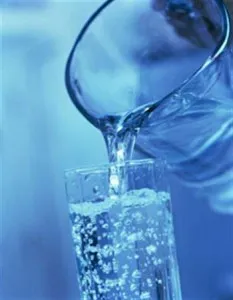
Benefits
of Drinking Alkaline, Ionized
Alkaline water is
a powerful antioxidant, it promotes detoxification, the
water’s hydrating power is second to none and it
helps balance the body’s pH.
Our body can be very acidic because of the types of food
we eat. When you drink a lot of soft drinks and frequently
take in fast foods and process foods, you are slowly building
up the acidity in your body. This makes you more prone
to diseases. A healthy body has a pH in the range of 7.34-7.40.
Drinking ionized water helps to detoxify the body of acid
waste. The ‘micro clustered’ water is able
to infiltrate tissue and cell walls more easily than normal
H2O, even areas that could not be reached before.
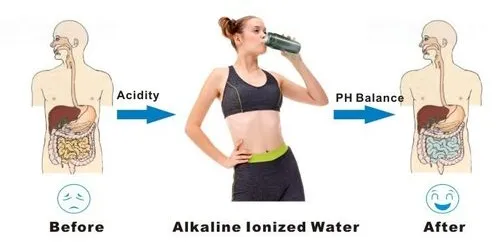

| How much water
do you need?
The equivalent of 8 cups of water for women
and 12 cups of water for men is the minimum amount
of fluid recommended daily to replace water losses
under conditions of moderate activity, mild temperature
and altitude
|
Oxidation
Reduction Potential (ORP)
When your tap water arrives at your home, it will usually
be a little over neutral in pH ~ around 7.5.
It will, however, be robbed of its electrical negative charge and will
almost always have a 'positive' ORP .
This means it has no antioxidant abilities and cannot assist your body
in the fight against oxygen free radicals. On the contrary, it actually
robs you of energy as you drink it.
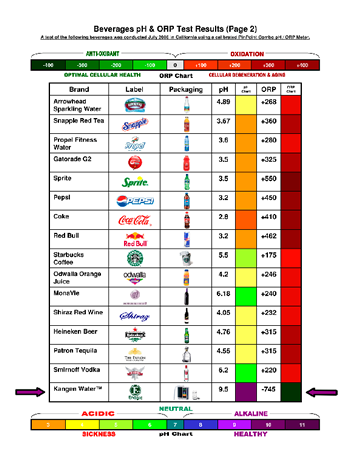
Click
to enlarge
The measurement of this positive or negative charge is
expressed in millivolts, so an ORP reading on our ORP meter
of tap water will most likely depending on your area show
around +350 millivolts. After it has been through Ionizing
Water filters it will most likely show anything from
-150 to -650mv (depending on the amount of soluble minerals
in the water and on the original pH of the water).
ORP is a "potential" energy that is stored and
ready to be put to work. An analogous way to look at ORP
would be to consider pressure. When you blow up a balloon
you use energy that creates force. As long as the balloon
remains closed, this force is a “stored potential
energy” in this case measured as air pressure. When
released, this “potential” energy becomes kinetic
energy.
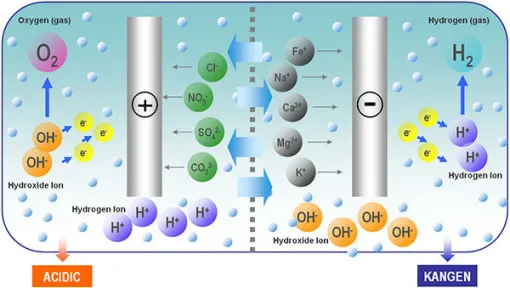
Potential electrical energy in liquid can be measured.
It is measured with an ORP meter. These meters display
extremely slight, and highly variable differences in the
electrical properties of water. ORP readings are expressed
in millivolts (1/1000 of a single volt). ORP meters range
in price from $100 for a handheld “tester” to
over $3,000 for more sophisticated laboratory equipment.
ORP measures the presence of oxidizing or [oxidation]
reducing agents by their specific electrical charge, thus
Oxidation Reduction "Potential". Oxidation in
simple terms is what turns an apple brown after it is cut
or causes metal to rust. Rust weakens metal and signifies
the deterioration of the apple. High pH water has more "reducing" agents
(-ORP) and low pH water has more oxidizing agents (+ORP).

In electrical terms, potential energy can be measured.
When we use the term "potential" in describing
ORP, we are actually talking about electrical potential
as expressed in millivolts. This potential is measured
in water with an ORP meter. What you measure is the very
slight voltage in water. We are actually measuring the
presence of oxidizing or reducing agents by their specific
electrical charge, thus Oxidation Reduction "Potential".
High pH water has more "reducing" agents (-ORP)
and low pH water has more oxidizing agents (+ORP).
The ORP of most tap water in the USA is between +150
to +600mv
and so is an oxidizing agent. High pH
ionized water demonstrates a –ORP
and so is a reducing agent or “antioxidant”.
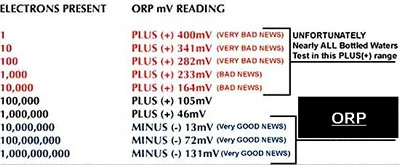
Aging or premature aging is a process of oxidation within
the body. In other words the body rusts and
is damaged by oxidation. The antioxidant
molecule has an extra ion and donates it to the free radical
effectively neutralizing it which is very important to
our health and longevity. This antioxidant effect is also
known as Oxidation Reduction Potential (ORP).
Air, food and water have an Oxidation Reduction Potential
(ORP) value which can be measured by an ORP meter which
is a millivolt measurement of negative and positive electrical
values .The higher the negative
ORP value the healthier is for us and more powerfully we
can neutralize free radicals
The
benefits of being well-hydrated:
Have you heard the saying that 8 glasses of water a day
helps keep your skin healthy? It's true, but there are
other benefits to getting those 8 glasses or more:
 Boosts
physical and mental endurance. Boosts
physical and mental endurance.
 Helps
maintain a pleasant demeanor. Dehydrated adults and
children tend to be irritable and/or lethargic. Helps
maintain a pleasant demeanor. Dehydrated adults and
children tend to be irritable and/or lethargic.
 Helps
prevent muscle cramps in your legs, hands, and feet
-- and achy stiffness in your joints. Helps
prevent muscle cramps in your legs, hands, and feet
-- and achy stiffness in your joints.
 Can
prevent headaches. Are you prone to migraines, cluster
headaches? Ask yourself how much water you drink in
a day. If it isn't at least 48 ounces (preferably more),
you might be dehydrated. Can
prevent headaches. Are you prone to migraines, cluster
headaches? Ask yourself how much water you drink in
a day. If it isn't at least 48 ounces (preferably more),
you might be dehydrated.
 Some
studies show hydration can decrease the risk of kidney
stones and lower the risk of certain cancers by helping
the body to flush out toxins. Some
studies show hydration can decrease the risk of kidney
stones and lower the risk of certain cancers by helping
the body to flush out toxins.
 Helps
keep your digestive system working. Fluids soften the
stools, making them easier to pass. Helps
keep your digestive system working. Fluids soften the
stools, making them easier to pass.
 Helps
prevent urinary tract infections by helping to flush
away bacteria. Helps
prevent urinary tract infections by helping to flush
away bacteria.
 Helps
keep pregnant women from being constipated -- and it
can also help the body flush away excess fluid that
can lead to bloating and edema (swelling). Helps
keep pregnant women from being constipated -- and it
can also help the body flush away excess fluid that
can lead to bloating and edema (swelling).
 Helps
nursing women with milk production. If you are having
a problem with milk supply, ask yourself how much water
you're drinking. Helps
nursing women with milk production. If you are having
a problem with milk supply, ask yourself how much water
you're drinking.
 Helps
keep your eyes and skin moist and healthy. When the
body is dehydrated, it looks for moisture from wherever
it can find it -- including the eyes and skin. Helps
keep your eyes and skin moist and healthy. When the
body is dehydrated, it looks for moisture from wherever
it can find it -- including the eyes and skin.
 Can
help asthmatics breathe more efficiently, according
to experts. Apparently, dehydration interferes with
how well the lungs function (thereby increasing the
likelihood of an asthma attack). Can
help asthmatics breathe more efficiently, according
to experts. Apparently, dehydration interferes with
how well the lungs function (thereby increasing the
likelihood of an asthma attack).
If dehydration is the removal of water
from an object, then the treatment of dehydration to reverse
its effects would logically be rehydration
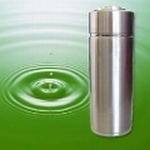
And
These are Amazing.
Effect of inadequate
water intake
Too little water can lead
to dehydration. If you are dehydrated, your blood is
literally thicker, and your body has to work much harder
to cause it to circulate. As a result, the brain becomes
less active, concentration becomes difficult & your
body feels fatigued. |
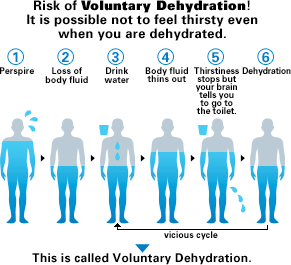
Are
you Dehydrated
Individuals' daily water requirements can vary due to
many factors - including amount of exercise performed,
total body weight, total lean muscle weight, and the temperature
and climate of your locale. Many people wait until they
are thirsty before reaching for a bottle of water. However,
thirst is a very unreliable measure of the water needs
for our bodies. The body can lose up to 2 or more cups
of water before thirst strikes. Not getting enough water
may result in a faster heart rate, thicker-than-normal
blood, lowered endurance capacities, and muscle cramps.
Drinking water in regular intervals throughout the day
is an important habit to develop.

Beverages containing alcohol and caffeine should not be
substituted for water. These types of beverages often have
diuretic properties, meaning that it encourages the body
to excrete more water. Diuretic substances promote dehydration.
Many believe that since these beverages are a liquid substance,
there is enough water in them to satisfy their daily water
requirements. This is untrue, as the chemical compounds
in these beverages cause you to let as much water go (if
not more) as you consume it.
Drink
to prevent thirst, not to quench it.
| While some water is available from the food we
eat, the majority of the water we need on a regular
basis must be provided by drinking pure water. The
consumption of tea, coffee, juice or soft drinks
should never be considered water intake. Many of
these drinks are so acidic that they end up pulling
more water from the cells to neutralize the acidity—making
dehydration even worse. |
Your body loses water even while sleeping.
Drinking a glass of water before going to bed or after
waking up will help your body function smoothly.
Water is so essential to the body, that it is a requirement
for proper immune system functioning. Whenever you get
sick, your body requires more water to help it fight off
infection. Fighting a cold or the flu can dehydrate your
body quickly.
| Common signs of dehydration that are often ignored
include dark urine, afternoon fatigue, heartburn,
dry skin, acne, headaches and constipation. If these
are ignored, more serious problems develop. |
The Signs and
Symptoms of Dehydration
Symptoms of dehydration usually begin
with thirst and progress to more alarming manifestations
as the need for water becomes more dire. The initial signs
and symptoms of mild dehydration in adults appear when
the body has lost about 2% of it's total fluid. These mild
dehydration symptoms are often (but not limited to):
 Thirst Thirst
 Loss
of Appetite Loss
of Appetite
 Dry
Skin Dry
Skin
 Skin
Flushing Skin
Flushing
 Dark
Colored Urine Dark
Colored Urine
 Dry
Mouth Dry
Mouth
 fatigue
or Weakness fatigue
or Weakness
 Chills Chills
 Head
Rushes Head
Rushes
Asthma:
Increased histamine production in the body from chronic dehydration
causes the bronchioles to spasm and constrict. This is an attempt
by the body to conserve water. Water is going to be lost through
respiration, so the lungs are trying to conserve what it can. |
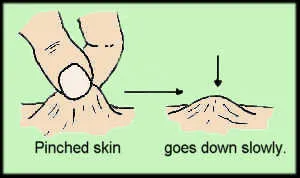 |
Try this
simple test: Gently pinch the skin
on the back of your hand between your thumb and
forefinger for 5 seconds. Then count how many seconds
it takes for the skin to flatten out again. The
length of time it takes can be correlated with
age, dehydration, and skin health. Generally, those
between the ages of 45 and 50 have a return-response
time under 5 seconds, but by the age of 60, the
amount of time it takes for the skin to return
to its original position is double or triple (10-15
seconds), and by the age of 70, the response time
is typically 35-50 seconds.
The lack of resiliency in older skin is
due to a loss of water. As we age, the thirst
mechanism declines and water is lost from
many areas of the body. The structure of
the water within our bodies also deteriorates
with age, making it less efficient and less
mobile. The aging process is literally a
withering of the tissues throughout the body–visibly
reflected in the skin.
|
If the dehydration is allowed to continue
unabated, when the total fluid loss reaches 5% the following
effects of dehydration are normally experienced:
 Increased
heart rate Increased
heart rate
 Increased
respiration Increased
respiration
 Decreased
sweating Decreased
sweating
 Decreased
urination Decreased
urination
 Increased
body temperature Increased
body temperature
 Extreme
fatigue Extreme
fatigue
 Muscle
cramps Muscle
cramps
 Headaches Headaches
 Nausea Nausea
 Tingling
of the limbs Tingling
of the limbs
Be aware that these are not the only symptoms of dehydration
that may manifest , these are simply the most common. Symptoms
of dehydration will differ from person to person because
the body is a complex network and everyone's body is different
During dehydration, the only areas of the body that receive
allotments are those where water is absolutely necessary.
Blood, brain, kidneys, liver and digestive organs all take
priority over the skin and connective tissues; without
water, they begin to dry up.
Your
Skin is often a very good pointer to your Bodies Hydration,,
Now you can measure your skin hydration
Easily Quickly and fairly Accurately
|

